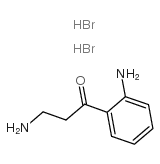Kynuramine Dihydrobromide

Kynuramine Dihydrobromide structure
|
Common Name | Kynuramine Dihydrobromide | ||
|---|---|---|---|---|
| CAS Number | 304-47-2 | Molecular Weight | 326.02800 | |
| Density | N/A | Boiling Point | 367.3ºC at 760mmHg | |
| Molecular Formula | C9H14Br2N2O | Melting Point | N/A | |
| MSDS | Chinese USA | Flash Point | 175.9ºC | |
|
Azure B and a synthetic structural analogue of methylene blue, ethylthioninium chloride, present with antidepressant-like properties.
Life Sci. 117(2) , 56-66, (2015) The phenothiazinium compound, methylene blue (MB), possesses diverse pharmacological actions and is attracting attention for the treatment of bipolar disorder and Alzheimer's disease. MB acts on both monoamine oxidase (MAO) and the nitric oxide (NO)-cGMP path... |
|
|
Synergistic antidepressant-like effect of ferulic acid in combination with piperine: involvement of monoaminergic system.
Metab. Brain Dis. 30 , 1505-14, (2015) The lifetime prevalence rate for major depressive disorder (MDD) is approximately 17 % for most developed countries around the world. Dietary polyphenols are currently used as an adjuvant therapy to accelerate the therapeutic efficacy on depression. Ferulic a... |
|
|
Selective monoamine oxidase B inhibition by an Aphanizomenon flos-aquae extract and by its constitutive active principles phycocyanin and mycosporine-like amino acids.
Phytomedicine 21(7) , 992-7, (2014) Aphanizomenon flos-aquae (AFA) is a fresh water unicellular blue-green alga that has been traditionally used for over 25 years for its health-enhancing properties. Recent studies have shown the ability of a proprietary AFA extract (Klamin(®)) to improve mood,... |
|
|
5-(2-Aminopropyl)indole (5-IT): a psychoactive substance used for recreational purposes is an inhibitor of human monoamine oxidase (MAO).
Drug Test. Anal. 6(7-8) , 607-13, (2014) 5-(2-Aminopropyl)indole (5-IT) is a psychoactive compound that has recently been associated with several fatal and non-fatal intoxications in a number of European countries. There are indications that acute effects may include symptoms of monoaminergic (e.g. ... |